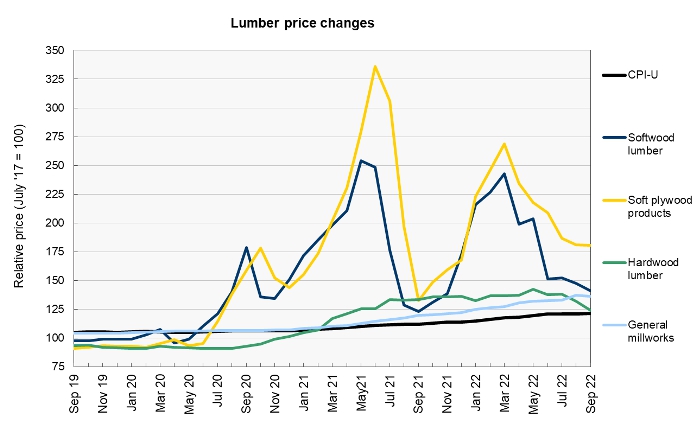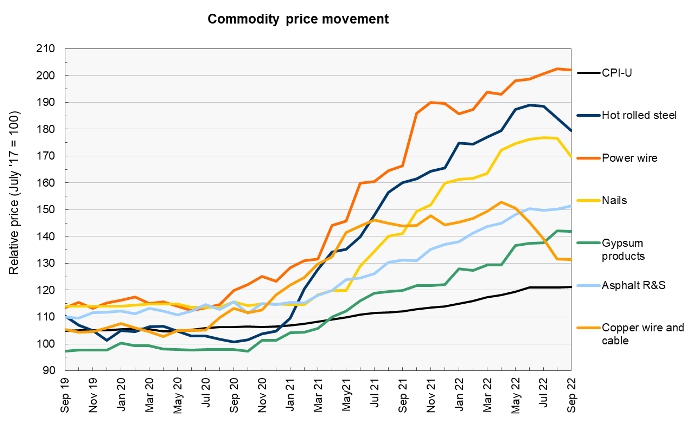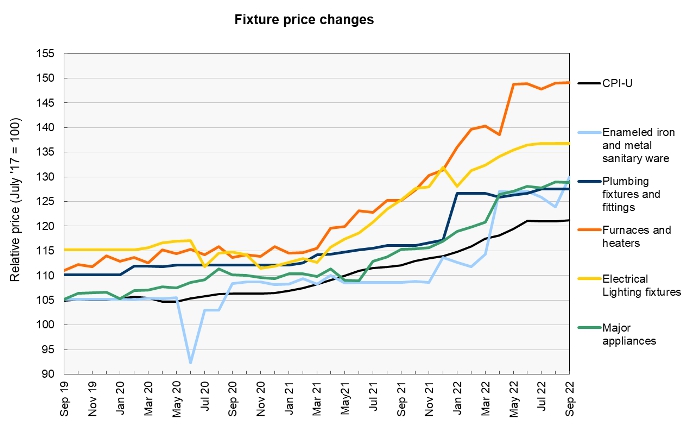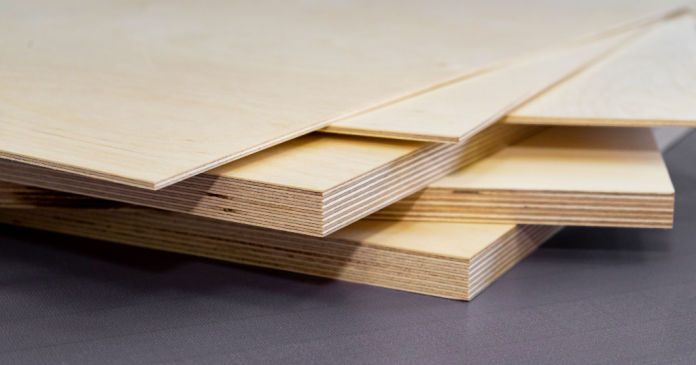The September producer price index (PPI) report from the Bureau of Labor Statistics (BLS) stated that construction materials prices fell 0.4 percent in the month, seasonally adjusted. While this decline is small, it may indicate that the recent slowdown in construction is finally reducing pressures on construction materials prices. However, the index was still 14.3 percent higher than its year-earlier level.
Overall prices for processed goods for intermediate demand rose by 0.1 percent in the month as rebounding fuel prices were offset by falling prices for materials and components for manufacturing. The processed goods for intermediate demand index was 13.1 percent higher than its year-ago level.
For reference, the changes in these indexes compare with an 8.2 percent rise in the all-items consumer price index (CPI-U) for the 12 months ending in September. The seasonally adjusted September CPI-U was up 0.4 percent from August’s level. The shelter portion of the CPI was up 0.7 percent for the month and was 6.6 percent higher than its year-ago level.
Yield Pro compiled the BLS reported changes for our standard list of construction materials prices. These are prices of materials which directly impact the cost of constructing an apartment building. The two right hand columns of the table provide the percent change in the price of the commodity from a year earlier (12 Mo PC Change) and the percent change in price from August 2022 (1 Mo PC Change). If no price data is available for a given commodity, the change is listed as N/A.
The pre-COVID column lists the change in the current construction materials prices relative to the average of prices from December 2019 through February 2020, before the pandemic impacted the economy. This may give a truer idea of the magnitude of the recent price increases for materials, such as lumber, whose prices were already rising sharply last year, than does the 12 Mo PC Change column.
| Commodity | 12 Mo PC Change | 1 Mo PC Change | Pre-covid Change |
| Softwood lumber | 14.5 | -4.6 | 40.5 |
| Hardwood lumber | -6.9 | -6.0 | 36.1 |
| General millworks | 13.8 | -0.8 | 30.1 |
| Soft plywood products | 36.4 | -0.2 | 95.0 |
| Hot rolled steel bars, plates and structural shapes | 12.1 | -2.5 | 73.3 |
| Copper wire and cable | -8.7 | -0.2 | 23.4 |
| Power wire and cable | 21.5 | -0.1 | 73.8 |
| Builder’s hardware | 13.3 | 0.0 | 25.8 |
| Plumbing fixtures and fittings | 9.9 | 0.0 | 15.2 |
| Enameled iron and metal sanitary ware | 19.7 | 4.9 | 23.6 |
| Furnaces and heaters | 19.1 | 0.1 | 31.3 |
| Sheet metal products | 15.1 | -0.7 | 47.2 |
| Electrical Lighting fixtures | 9.1 | 0.0 | 18.8 |
| Nails | 20.3 | -3.9 | 48.6 |
| Major appliances | 11.7 | -0.1 | 21.2 |
| Flat glass | 17.3 | 0.7 | 29.2 |
| Ready mix concrete | 11.6 | 1.1 | 19.8 |
| Asphalt roofing and siding | 15.3 | 0.8 | 35.4 |
| Gypsum products | 18.4 | -0.1 | 43.1 |
| Mineral wool insulation | 14.3 | 0.3 | 40.3 |
The first chart, below, shows the price index history for wood products over the past 37 months. Note that the prices used by the BLS in compiling the indexes are collected on the Tuesday of the week containing the 13th day of the month. In September 2022 that would have been September 13.

The prices of wood products continued their downward trend this month, with prices falling for all four of the lumber categories we track. Early in the pandemic, lumber price gains greatly exceeded those of the other commodities we track. However, with the exception of plywood products, lumber price gains since the start of the pandemic are now only just in line with those of many of the other commodities covered here. Also, while lumber prices are still mostly up year-over-year, the reported gains are accentuated by last September’s lumber prices being the lowest they have been in the last two years.
Markets Insider reported that the market price of lumber fell in late September but has been trending higher in early October. It closed on October 11 at $479, down $81 since September 13. This suggests that the price of lumber may again fall in next month’s PPI report. Lumber prices in the futures markets have fallen since last month, despite moving higher in recent days. The November 2022 futures contract closed at $479 on October 11, down $68 since our last report. The January 2023 contract closed at $473, down $67 since our last report, while the March 2023 contract closed at $491.
The next chart, below, shows the recent history of several other construction materials prices. These are relatively simple commodities whose prices are strongly driven by those of the materials of which they are comprised.

After rising steadily for nearly two years, the prices of some of these commodities have been declining recently. However, the price of power wire has held steady and is now at the highest level relative to its price on our reference date of July 2017 of any of the commodities that we track. Compared to the pre-pandemic level, its price rise is only exceeded by that of soft plywood products.
The biggest price move this month among these commodities was for nails, whose price fell 3.9 percent. The price of hot rolled steel was reported to fall 2.5 percent in September, but this was due to a 4.4 percent upward revision to the August price of this commodity. A significant revision was also made to the price of copper wire. Its August price was revised lower by 3.8 percent. Therefore, while the September price was reported to fall by 0.2 percent, it is actually 4.0 percent lower than the preliminary price estimate reported last month.
MarketWatch reports that the NYSE American steel index was steady for much of the month of September but has moved lower in October. It closed on October 11 at $1,475, down $57 from its level of a month ago. Steel futures have also moved lower since mid-September. The November 2022 contract closed on October 11 down 17 percent from its level on September 13. The January 2023 contract is down 16 percent over the past month.
The price of copper has been declining slowly since we last reported on it. It closed at $3.56 per pound on September 13 while it closed at $3.46 per pound on October 11.
The price of aluminum dipped in late September but rebounded in October. It closed on October 11 at $2,336, up $23 since our last report.
Price changes for several of the more finished goods from our sample are illustrated in the final chart, below. They generally continued their steady move higher. However, the price indexes for furnaces and heaters for the four prior months, May through August, included in this month’s report were all revised higher by around 4 percent. These are unusually large revisions and may indicate a change in data collection methodology that would have also affected earlier price indexes if that data was available.

The full BLS report can be found here.















